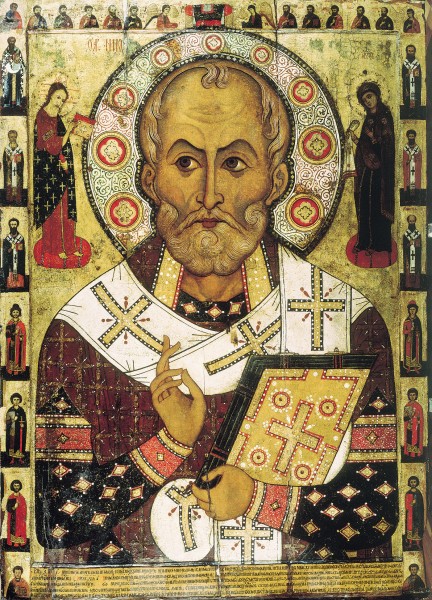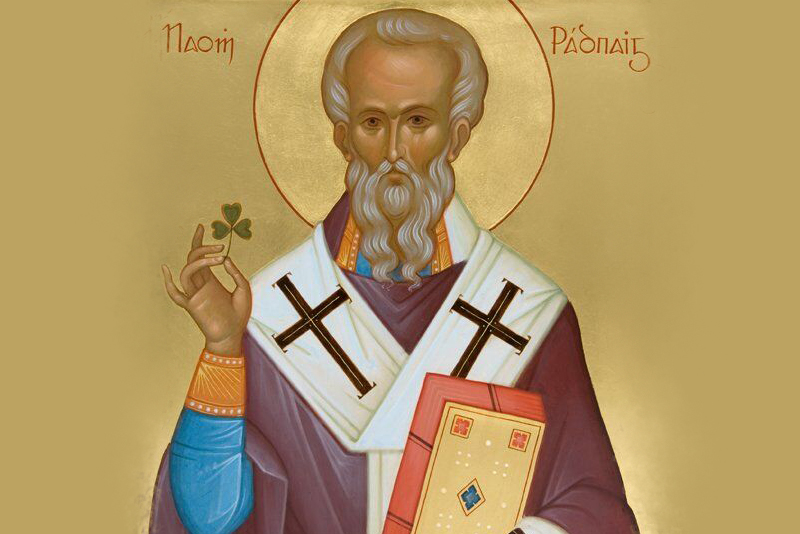
The biography of Saint Nicholas the Wonderworker incorporated the biographies of two saints: St. Nicholas of Myra in Lycia and St. Nicholas of Pinara.
The first of the two saints, Saint Nicholas of Myra in Lycia, lived in the 3rd-4th centuries. The first known written accounts of his life date back to the 5th and early 6th century. He was mentioned in the so-called Act of Stratelates. By the time this popular story spread the fame of St. Nicholas across the Byzantine Empire, there had been no written life of this saint yet. The first prayers to this saint appeared in the 6th century.
The first biography of St. Nicholas was compiled by a Michael the Archimandrite in the early 9th century. The author mentions some previously unknown facts of the holy hierarch’s birth and life. This biography gains widespread popularity in the Byzantine ecumene. It is copied and expanded. The biography of St. Nicholas, bishop of Myra in Lycia, and the biography of St. Nicholas of Pinara are merged together in the 10th century.
St. Nicholas of Pinara lived in the first half–mid-6th century; he was brought up in the faith since young age. He excelled in his studies. He made a pilgrimage to the Holy Land with his uncle. He visited Jerusalem and Egypt. He was tonsured a reader, a deacon, a priest, and finally founded his own monastery of Holy Sion, in honor of the Holy Mount Zion where the Last Supper had allegedly taken place. Nicholas organizes monastic life and charitable efforts in his monastery.
Perhaps, one of the reasons the two saints were mixed up was the fact that their death dates were close: St. Nicholas of Myra died on December 6 O.S., while St. Nicholas of Pinara died on December 10 O.S.
Someone merged the two biographies together in the 10th century. The unknown author took the biography of St. Nicholas of Myra as the basis and filled in the gaps, e.g., his parents, his childhood, miracles he performed when he was young, such as the miracle he performed while learning, and other actions. This compilation became popular and was later distributed as one text.

In the end of the 10th century, Symeon the Metaphrast, a renowned Byzantine hagiographer, edited this compilation and included it in his Menologion, thus effectively sanctioning it with his authority. He also added the mention of the participation of Saint Nicholas in the First Ecumenical Council in Nicea.
In fact, we don’t see the name of Nicholas of Myra in Lycia in the earliest lists of the bishops who participated in the First Ecumenical Council, although Myra was likely the capital of Lycia, and therefore its bishop had to be the metropolitan of the entire region and was therefore inevitably eligible to participate in the Council and to sign its acts. Of course, we may speculate that the metropolitan of Lycia didn’t stay at the Council till its end.
No one questioned the authenticity of the biography of Saint Nicholas in the Middle Ages and in the early modern period. The first scholar to pay attention to the loose ends of the classical biography of Saint Nicholas was Archimandrite Antonin (Kapustin), a Russian researcher and a prominent religious figure of the 19th century. In particular, he noticed that the chronology of the events described in the biography seemed to be broken. First, Saint Nicholas of Myra ostensibly comes to Palestine where the door of the Church of Resurrection springs open for him; and then he returns to Lycia, suffers martyrdom in the persecution of Diocletian; and then becomes a bishop. It is common knowledge that the Church of Resurrection was constructed in the time of Emperor Constantine, that is, after the persecution of Christians, which took place in the time of Emperor Diocletian. He began digging it up, found the life of St. Nicholas of Pinara and finally came up with the solution to this mystery. Final proof of his hypothesis was provided by Gustav Anrich, a German scholar of the late 19th – early 20th century, who collected almost all texts about Nicholas, which we continue to use today. It was thanks to his research that the fact that there were two different people described under one cover became indisputable for modern science. By the way, this “scientific fact” did not impact the popular veneration of Saint Nicholas of Myra who remains the most favorite saint for many people in various countries.
Translated by The Catalog of Good Deeds



